15 Ways to Reduce Waste in the Bathroom
Part 1 in our series: Reducing Waste Around the House
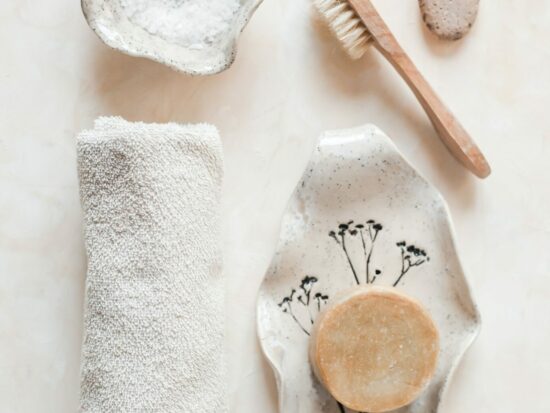
The bathroom can be one of the biggest culprits of waste generation, from water usage to product packaging to disposables and beyond. Below we have compiled some of our best tips for reducing waste in the bathroom. You will likely find that by implementing even just a few of the tips, you will save money and time!
Water Usage
- Start out by calculating your water footprint – Check out a free online calculator here.
- Cut off a minute (or more!) of your shower or use one less inch of bathwater – To help you keep track of time spent in the shower, try making a playlist that is exactly how long you want to spend in the shower. Alternately, set a timer at the midway point and final time of your shower for pacing. To keep track of bathwater, try using a bath or wax crayon on the tub to mark your new fill line.
- Turn off the faucet while brushing your teeth, shaving, or washing your face – Those extra seconds add up over time. Consider need vs. want to find a healthy balance in water usage.
- Install low flow faucets, shower heads, and toilets – Another option to reduce a toilet’s water usage (and one especially helpful for renters) is to refill a single-use water bottle and place it in the toilet’s water tank. This displaces the water and causes your toilet to use less water each flush. According to some sources, you can save about a third of a gallon of water each time you flush!
- Keep a bucket in the shower or tub to collect cold water – If you are particularly water savvy, collect the cold water that comes out on the front end of a hot shower or bath and use it to water plants, flush the toilet, fill the pet’s water dish, etc.
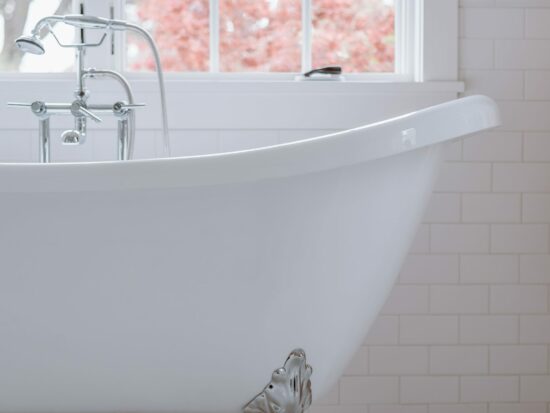
Shower and Bath Products
- Buy in bulk, buy concentrates, or buy bars – Buying this way can not only save you money, but it also often saves waste generated in shipping and/or packaging. Our favorite company for shower and bath products is Carina Organics. We buy their shampoo+body wash, conditioner, and bubble bath once or twice a year, and we buy in bulk (although, they do have smaller sizing options available as well). For makeup remover and baby shampoo, we buy Branch Basics’ concentrate (new customers get $10 off using our link). For Erica’s shaving soap/body soap, we buy soap bars from Earthy Browns, specifically their rounds (which come package-free and are made from the leftovers of the rectangular bars — a double win on the zero waste front!).
- Switch from disposable razors to a safety razor – Edwin Jagger is our favorite brand for quality safety razors. You can purchase from their website or even through Amazon. After the initial cost of purchase, safety razors rack up just a handful of change for each blade. Additionally, the blades can be recycled along with other metal products at designated facilities.
- Keep bar soap on a ledge to dry between uses or use a soap pouch – For those who use bar soap, keeping the soap dry is important to keep unnecessary residue from building up in the shower and bathtub, as well as to ensure it lasts as long as it can. For soap pouches, you can DIY one, or check out this one or this one.
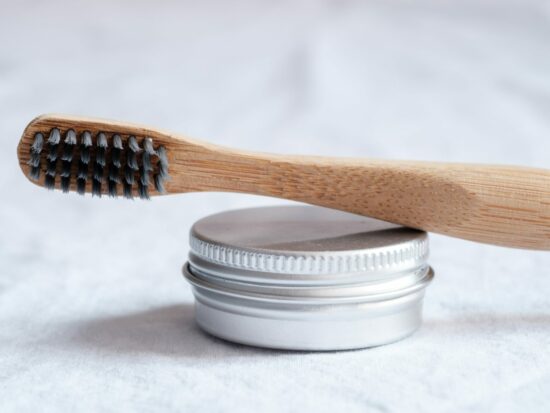
Personal Care Products
- Purchase reusable items rather than single-use items – Think makeup remover wipes, cotton rounds, tissues, menstrual products, etc. Buy once and buy the best quality you can afford. If you are really crunchy, you may even consider using cloth wipes for the toilet rather than disposable toilet paper. There are many Etsy shops that offer 100% cotton and organic cotton options for this.
- Buy plastic free (or reduced plastic) toothbrushes, toothpaste, and floss – OraWellness sells Erica’s favorite bamboo toothbrushes and toothpaste alternatives (packaged in glass!). For floss, you can try something simple like cotton thread, or check out Dental Lace or Living Home’s compostable floss.
- Buy cosmetics and body care items in bulk and/or in recyclable containers – We purchase bulk body lotion, again from Carina Organics. For bulk hand and dish soap, we use Branch Basics’ concentrate and gallon jugs of Earthy Browns’ liquid soap (we bring back our empty containers for Paul to reuse). For cosmetics and other body care items, we like to buy from Poofy Organics, Toups and Co., and Rowe Casa Organics. Each company has products with clean ingredients and packaging that is recyclable.
- A note on sourcing – If you are ever curious about the ingredients in a personal care product, check out Andrea’s Switch Natural app. The one time cost is well worth the ease of being able to scan a personal care product’s ingredients and quickly note any red flag ingredients. This app also links research behind why certain ingredients are considered red flags, so you don’t have to take Andrea’s word for things.
- A note on DIY – Although Erica used to DIY some makeup, at times it she found that DIY generated MORE packaging waste and less fresh ingredients over time. There are lots of recipes online, however, if you decide that it makes more sense for you to go the DIY route. One product that Erica has saved a lot of money and packaging waste on is her zero waste, 5 minute, DIY eyeliner (click the link to see her recipe!).
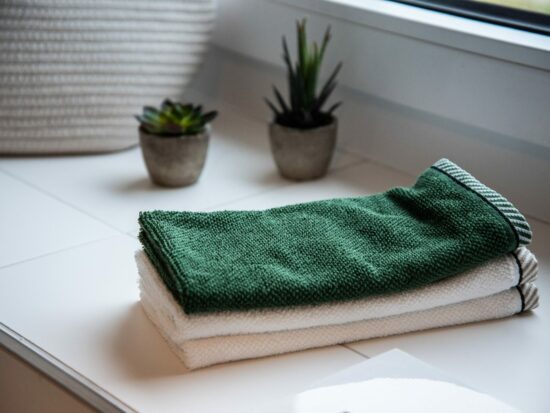
Fabrics in the Bathroom
- Look for 100% cotton towels – Many towels on the market are made by blending synthetic fibers and cotton. These are best to avoid, as they shed microfibers (the most prevalent form of microplastic) and can be particularly harsh on sensitive skin. Instead of cotton-blend hand and bath towels, look for 100% cotton, untreated (no stain-repellent or the like) towels. Bonus points if you can purchase un-dyed or naturally dyed, organic cotton. Conventional cotton’s heavy insecticide and pesticide use has given it the title of dirtiest crop on earth, and the ingredients in many textile dyes have harmful effects on health and the environment.
- A note on stains – If your towels do happen to get stained, try running a load with a non-toxic oxygen booster like this one (and yes, its color safe!).
- Opt for a natural fabric shower curtain liner – Beyond the extensive environmental concerns, many plastic-based fabrics have been shown to have adverse affects on our health. In a bathroom this is even more of a concern considering each fabric’s frequent use and the additional exposure to heat/steam. Instead of going the PVC/vinyl shower curtain liner route, try a linen or natural fabric liner like this one.
- Hang your fabric items in a way that promotes drying – Although a seemingly small tweak, making sure to hang your hand and bath towels and bath mat properly can mean less frequent laundering is needed and that there is less opportunity for musty, moldy smells to develop. When and where available, we like to install towel hooks or bars near air vents and windows, as that extra air flow helps to speed up drying time.
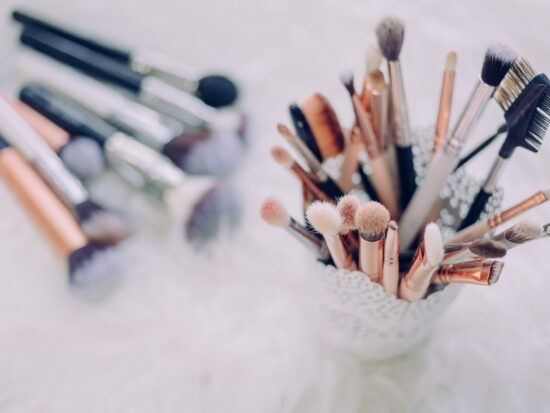
A final tip to reduce waste in the bathroom…
- Buy less, buy better – Perhaps this tip should have come first! After all, less stuff means less clutter and maintenance required. For example, instead of buying five cheap tubes of lipstick or bottles of cologne, how about finding one or two high-quality, low-tox options? Instead of keeping four toothbrushes for one person out at a time or stuffed in your toiletries bag, how about getting on a schedule of switching your old toothbrush with a new one every three months? (If you are not ready to recycle your old toothbrush, try keeping it in your cleaning caddy. It might come in handy for those grout lines or around the toilet seat. Just make sure to label it as a cleaning-only toothbrush.) Your future self will thank you for thoughtfully choosing what to bring into your bathroom! Buy less + when you do buy, buy better!
There you have it! 15 ways to reduce waste in the bathroom. Did we miss anything? Comment below to share your ideas with our community!
If you liked this article, you might enjoy perusing our other bathroom and shower recommendations located under our Recommendations page.
Yours truly,
Erica Barlow


 Our Favorite Small Businesses: A Gift Guide
Our Favorite Small Businesses: A Gift Guide